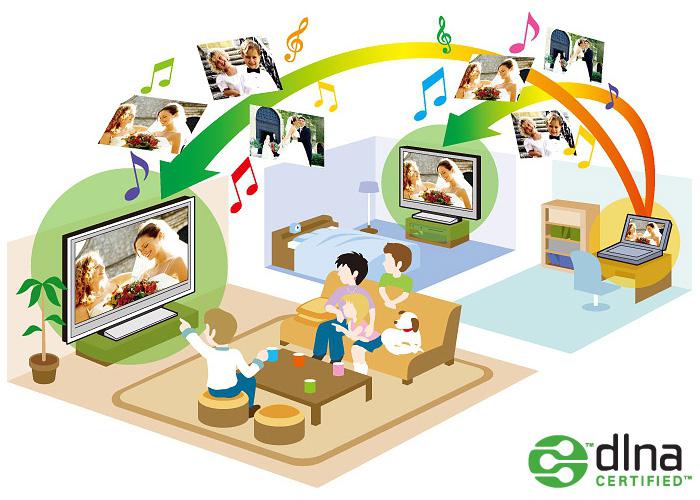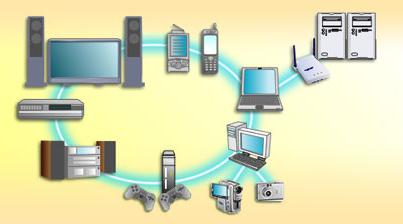When buying modern multimedia technology, you can see the DLNA logo. This means that this device can be connected to a home network to transmit and receive a variety of media content. And all this will happen in real time.
How it works
To better understand how DLNA works, what a home network is, what are the benefits of using this system, imagine this situation. You have downloaded the movie on the Internet and want to watch it on your TV. But to do this, you need to burn the movie to disk or flash drive. Moreover, if you use a disc, then you need a multimedia player to play it. So it was before, now with the help of a special protocol for the exchange of information called DLNA, you can forget about all the extra body movements. This protocol provides communication between all devices supporting it, which, in fact, allows you to create a home network. In this case, a personal computer acts as a kind of server, and a TV or other device as a client.

The main advantage of such a scheme is that you can instantly, without any complicated operations, access data stored on any of your home devices. You downloaded the film to your computer - and you can immediately watch it on TV. If you take beautiful photos on a digital camera or phone, you can immediately evaluate them on a computer screen or arrange a spectacular slide show using a TV. Even greater opportunities open up for lovers of good music, because now it’s enough to record your favorite song on any DLNA compatible device to listen to it later using the music center.
Create your own network
First of all, you need to understand that there are two types of devices that support this protocol. More specifically, the DLNA client and the DLNA server. What is a client, you probably guess. This is a device for receiving signals. But the server, by contrast, is designed to transmit data. Most modern televisions can be used as a DLNA client, and those that for some reason do not have such a function can be connected to the network using a media player that supports the desired protocol. Network storages will always be only servers, but computers, smartphones and tablets are both servers and clients.

To transmit a signal, both wired and wireless connections are used. To create a Windows DLNA server , you probably will not even need to install additional software. Simply make one of the folders or the entire hard disk open for viewing by other devices. Some more problems will be with other operating systems. To turn a Linux or IOS-based computer into a DLNA server, you need to install specialized software, which may well be paid. The situation is similar with all mobile devices for which there are many relevant applications. By the way, if you need a DLNA media server , it is most reasonable to use network storage for these purposes .
Device connection
As mentioned earlier, most modern TVs and music centers initially support DLNA. What is this support? In essence, this means that the TV can independently connect to a wireless or wired network without additional devices. Well, and accordingly, it is able to receive data using the DLNA protocol. At the same time, to access shared files, simply click on the corresponding button on the remote control, after which the TV will automatically find the DLNA server. Next, you select the desired movie or other media file from the list that appears.
disadvantages
Among the main disadvantages of this technology, the compatibility of different software is the most problematic. This problem can often be solved by installing the software recommended by the manufacturer for this model of server or TV.
Also, when downloading movies from the Internet, it should be remembered that most TVs support only certain formats, among which usually mpg4, avi and wmv. Other types of codecs may not be readable by some models. But this problem can be solved by buying a multimedia player.
If a wireless network is used for data transfer, a weak signal of the Wi-Fi receiver can cause delays in playing the movie. Especially if you watch high quality video. There are two ways to solve the problem. By amplifying the signal of the router, moving it closer to the TV, or connecting the TV to the network using a wire.
Output
Now that you know how to use DLNA, what file sharing is and how it all works, setting up your own home network should not be a problem for you. This means that you can fully enjoy all the benefits of file sharing.